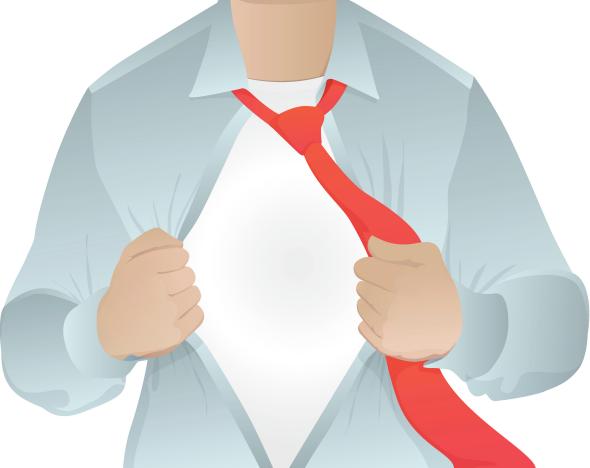Undershirts Are a Proud American Tradition

graphicgeoff/Thinkstock
What is the Ur-American garment, the item of clothing that best represents our great pluralist nation?
Partisans of our Western mythos might claim that denim jeans and Stetson hats symbolize our resilience and hardiness, not to mention our colonialist tendencies. A Down Easter could make a case for the practical, jolie-laide duck boots that have been keeping Mainers’ feet dry since Jessica Fletcher was a girl. Someone would surely nominate Malcolm X’s zoot suit—its “killer-diller coat with a drape shape, reet pleats and shoulders padded like a lunatic's cell” ably represents black America’s massive influence on global fashion. Sportswear separates, a supremely practical American invention, represent the marriage of capitalism and style.
Still, for me, the stand-out sartorial symbol of the United States is the plain white T-shirt, the sort one spys peeping out between the opening of an unbuttoned collar. The humble undershirt is America’s greatest gift to the world’s wardrobe, and like every normal cross-dressing lesbian American—nay, every normal American of any caste or creed—I wear one every day.
Undershirts aren’t an exclusively American phenomenon, of course. Savvy citizens of the world’s colder climates don cotton tank tops or high-tech heat-retaining V-necks as their innermost layer of clothing to provide warmth and comfort. Residents of global hot zones know that a thin substrata of cotton can prevent obvious sweat stains and lengthen the life of their dress shirts. It is only in America, though, that we take so much pride in our undershirts that we display them for all to see. The V of visible T proclaims, “I am an American, I work so hard that I sweat, but thanks to this wondrous item of clothing, that won’t prevent me from offering up an extra couple of hours of unpaid labor after my shift is complete. Just because.”
As is so often the case in immigrant stories, my journey to obvious undershirt wearing was facilitated by television. When I was a child, my mother insisted that I always layer a vest—as we call undershirts in Britain—under my school uniform to ward off the Manchester damp. My teenage rebellion involved throwing out the vests and embracing another American invention: the slogan shirt. I spent more than a decade as a human billboard, considering it my duty to inform everyone I met where I’d vacationed, which bands I liked, and which political factions I supported. In my 30s, I started to cover my talky T-shirts with V-neck sweaters. It was only when I moved to New York, a city where even magazine journalists can’t escape the tyranny of collars, that I purchased a cache of dedicated undershirts.
My inspiration came from television’s most-popular drama, NCIS. On that CBS workhorse, Mark Harmon plays Leroy Jethro Gibbs, the undisputed leader of a team of Naval Criminal Investigative Service agents. Gibbs is humble, hardworking, and a little bit rumpled. The only way the show could make Harmon—a former college quarterback who in 1986 was named People magazine’s Sexiest Man Alive—seem dowdy was to saddle him with some all-American underwear. As Slate’s Troy Patterson explained in 2008, “The choppy haircut, the noxiously patterned sport coats, the perpetual wedge of white undershirt under his floppy open collar—these all communicate that the man's lack of polish is proof of his trustworthiness.” I became a U.S. citizen the day I took the oath of allegiance, but I became a real American when I first started to dress like Leroy Jethro Gibbs.
I was surprised to learn that starting to wear undershirts is a common—you might even say normal—stage of modern maturity. In an informal survey of my Slate colleagues, I learned that more than three-quarters regularly wear undershirts—though several women told me they hadn’t previously given that name to their camisoles, tank tops, or long silk underwear. Most said they wore them for warmth, increased layering flexibility, or to provide a barrier between skin and itchy wool. Some women also mentioned a desire to increase the opacity of see-through blouses or to avoid the dreaded “button-down boob gap.”
Several people told me that their undershirt habits had changed as they got older. For some, advancing age brought increased sweatiness, and an undershirt suddenly seemed necessary to protect fancy shirts from bodily fluids; others said they’d started to wear camisoles after having kids. One mentioned buying undershirts as a rite of passage—the stack of new T’s represented a break from the youthful habit of making do with whatever was at hand. (In The Wire, when Bubbles tried to make a fresh start by selling packs of fresh white T-shirts from a rickety supermarket cart, the choice of goods was surely significant.)
Once upon a time, undershirts were as universal as hats, and while it might be an urban myth that sales tanked after Clark Gable took off his shirt in It Happened One Night (1934) and revealed a bare chest, their popularity ebbs and flows like the tides. I admit I have no evidence to support my theory that undershirt visibility increases when the state of the nation is strong (and thus European fashion influence is weak), but I echo the view of the anonymous Slate colleague who declared, “More people should wear undershirts. I don't want to see your chest hair, nipples, and flesh peeking through your work clothes.”
Donning a fresh white undershirt always makes me feel alert, smart, and professional—even though my hero, Leroy Jethro Gibbs, has abandoned them. Last year, in NCIS’s 13th season, after a near-death experience, Gibbs threw out his undershirts. The show hasn’t been the same since.
Read more from Normal, Slate's pop-up blog about how you're supposed to do it.

